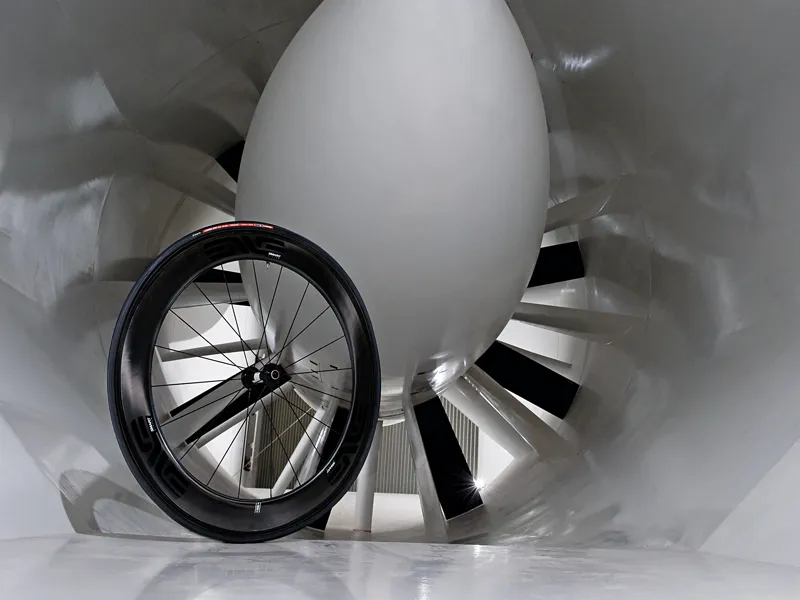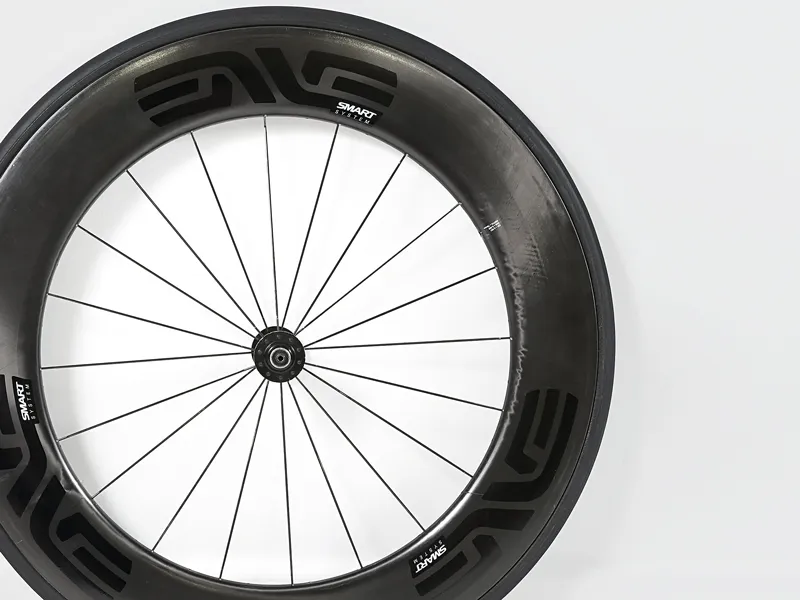The Enve 6.7, the first wheelset in Enve's new aero wheel range developed in conjunction with Simon Smart, is set to go on sale in June. Over the past year, Procycling has tracked the development progress of these wheels from start to finish. Here's the inside line on what's gone into them to make them so fast.
Enve Composites, based in Utah USA, are a young, vibrant and ambitious company that have experienced huge growth in a short time. They launched in 2007 with ultra-light carbon fibre wheels, forks and components and already their wheels have been ridden by several top teams. The company - formerly Edge - then started to consider the aero market.
Beverly Lucas, Enve's vice president of global sales and marketing, remembers the pivotal moment. "We'd been to the San Diego wind tunnel with our stuff in November 2008 and it tested well but not as good as any of us really wanted it to. We wanted to go really big but knew we had to make a bigger investment in order to make that happen."
The aero wheel market is packed and fiercely contested between several well established brands with many years of development behind them - you don't simply walk in. Lucas says the solution arrived by chance: "I'd come to the UK on business in March 2009 and I was watching the Australian Formula One GP in the hotel. Back then we were sponsoring Fly V which also had Virgin branding. Then on the television I saw the Brawn GP car wheeled out and it had a Virgin sticker on the nose. I made some calls and got a contact at Brawn GP and requested a meeting with them. They put me onto Simon Smart who had a contract to use their wind tunnel. From the first time we met I knew he was the guy we needed."
As well as having ten years of experience in F1 and two of the fastest and most successful time trial bikes on his CV, Smart is a keen and rapid time triallist himself. But most crucially, he was already thinking along the same lines as Enve. The development of the Giant and Scott time trial bikes had involved a lot of wheel testing and he'd soon started having ideas on how to make faster wheels than were currently offered. He just needed a manufacturing partner...
It was a perfect fit. If Enve had any doubts, it was that they might bite off more than they could chew. "I can't tell you how much throught went into this project before we committed," says Lucas. "We had to be sure we could actually make what simon came up with"
It was decided that the new range should consist of three wheelsets shaped to fit particular scenarios: a climbing and multi-purpose set, a mid-depth road race and TT pair, and a flat-out TT set. Smart first set about conceiving a new R&D method. With an agreed target of nothing less than ‘making the most aerodynamic wheel range in the world’, and a number of ideas stored up from his work in frame design, Smart knew that faster wheels had to start from better testing protocols.
He was also convinced that there was plenty of room above the best existing wheels: “There are some good products out there but none tick all the boxes. Enve has a massive opportunity,” he told Procycling in May 2010.
Method
It was clear from the start that wheel testing had to be done in a bike. “It doesn’t take Einstein to work out that when you put a wheel in the bike the flow it’s seeing is being interfered with,” said Smart. The current leaders in the aero wheel industry agree – Zipp and Hed developed their latest generations with Cervélo and Trek respectively. However, Smart wanted to extend the testing method further and give buyers a range of wheels that would work in a broader spectrum of bikes.
“The development of one wheel in one bike is limited because of the huge choice of designs out there. For example, you could [run your own test] with a Cervélo P3 and you’d choose a Zipp 808. You do the same test on another bike like the Trek or Giant and you’d choose a Hed S9. The consumers are completely baffled by all this information so really the strategy is to try to develop a range of wheels that work in many different bikes.
"We are investing a huge amount of money in doing all this development for the wheels and we can hand that knowledge on to the consumer to make sure they are actually buying a wheelset that goes fast when they put it in their bike. it’s an exciting challenge to make wheels that work in multiple bikes.”
Smart’s process therefore requires wheel concepts to prove themselves in two very different TT bikes, the Cervélo P3 and Trek Speed concept, and two road bikes, the Cannondale SuperSix and Specialized Tarmac. On top of this, the Scott Addict-based development rig built by Smart exclusively for Enve can include a dummy rider and ensures a high degree of accuracy for repeatable measurement of marginal improvements. Other metrics are recorded, too, but they’re kept secret.
In terms of ride quality, the new aspect that Smart and Enve wanted to pursue was stability in crosswinds. Many wheels are sold on their aero performance at a particular crosswind yaw angle, “so you’ve got this sweet spot but can you ride it?” says Smart. “Many wheels are too unstable at their most effective angle. The big compromise is rim depth versus stability. So in the wind tunnel we’re doing some really unique stuff. We’re going to be the first to test stability in a wind tunnel. We’ve got a stiffness target, a weight target, a stability target and a drag target and we’re going to put all those in the pot and test all these variations of rim width and depth.”
The pressure of producing and testing that many variations led to another innovation – a proprietary rapid prototyping system. “It allows us to test many more rim shapes in a smaller timeframe and with a greater degree of fidelity,” says Simon.
Enve place such a high value on this innovation that the exact details of it are kept secret, but we can disclose that it allows the bike to stay on the rig while prototype versions are swapped. This means it avoids the risk of introducing any error and saves time.
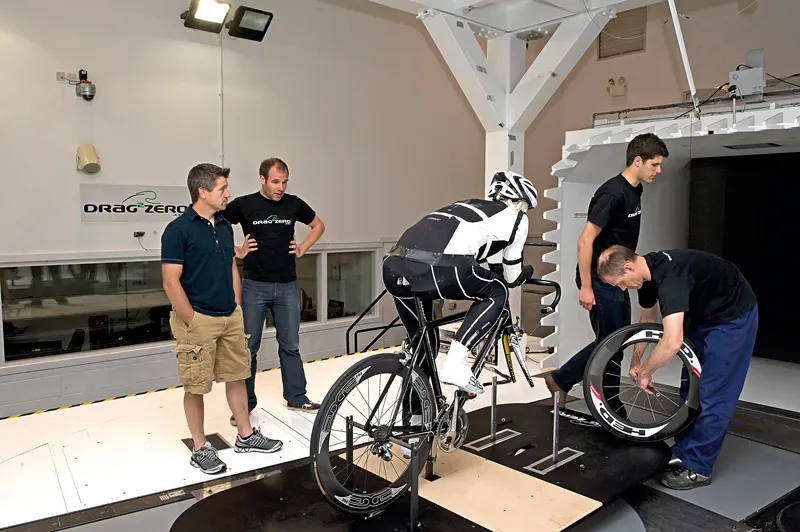
Early development work was carried out using the still secret and patent pending test rig
First test
The first wind tunnel test is in May 2010.
The aims are to confirm the computer modelling and create a shortlist of rim cross-sections. There are at least 19 profiles to be tested – five overall shapes are narrowed down to two, then seven micro-variations of each – and all at a full range of yaw angles and in at least two of the four bikes Smart has picked out. A measurable change in aerodynamic behaviour and crosswind stability can be seen from a change to the rim width as small as 0.2mm.
“Half a millimetre can generate a difference of five or six watts,” says Simon. After 50km that could yield as much as 18 seconds – enough to win a grand tour, let alone a club time trial.
There’s a huge amount of work to get through but behind the focus is nervous excitement. even if they won’t quite say as much, it’s a very big day in Enve’s ambitious future. in attendance are: Brett Satterthwaite, Enve co-founder, fluid dynamicist and civil engineer; Kevin Nelson, design engineer; marketing VP Lucas, who also has a construction engineering degree; and mechanical engineer and ex-F1 aerodynamicist Smart. in this company, Procycling feels extremely unintelligent and concentrates hard on not asking stupid questions.
Sound engineering, state-of-the-art technology and a team of brains like a multi-core supercomputer mean that there are no significant surprises or disappointments through the initial phase of testing. The shapes that looked the best in the computer are performing the best in the tunnel.
“This first test gave us results that we’d have been happy with as a final outcome,” Nelson comments later. One indicator of this early success is that the first patent is filed immediately after the test. With that result in the bag, there’s a new confidence and eagerness to see what more can be achieved.
With so many performance targets, aesthetics couldn’t be a factor even if Enve – never knowingly overstated – wanted it to be. “We’re straight down the line form-follows-function. if the fastest shape looks like a cow then the new wheel will look like a cow,” says Lucas. While it’s already near certain that the new wheels will actually be black and round, they will differ significantly from anything else on the market, as Smart explains:
“The rim cross-sections will definitely be different front to rear because of the interaction with the bike and the flow past the rider’s legs. No one else does that but we know it’s the way to go. The front and rear wheels have unique jobs to do because they see totally different air flow.”
The drag data: Enve wheels vs other top brands in road and TT bikes
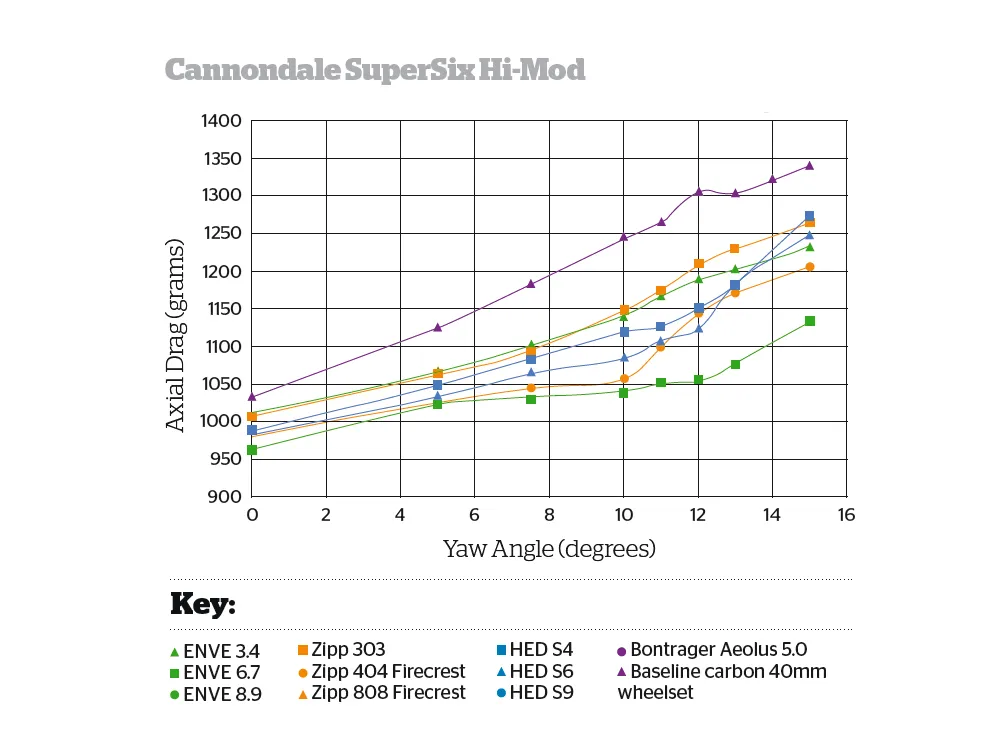
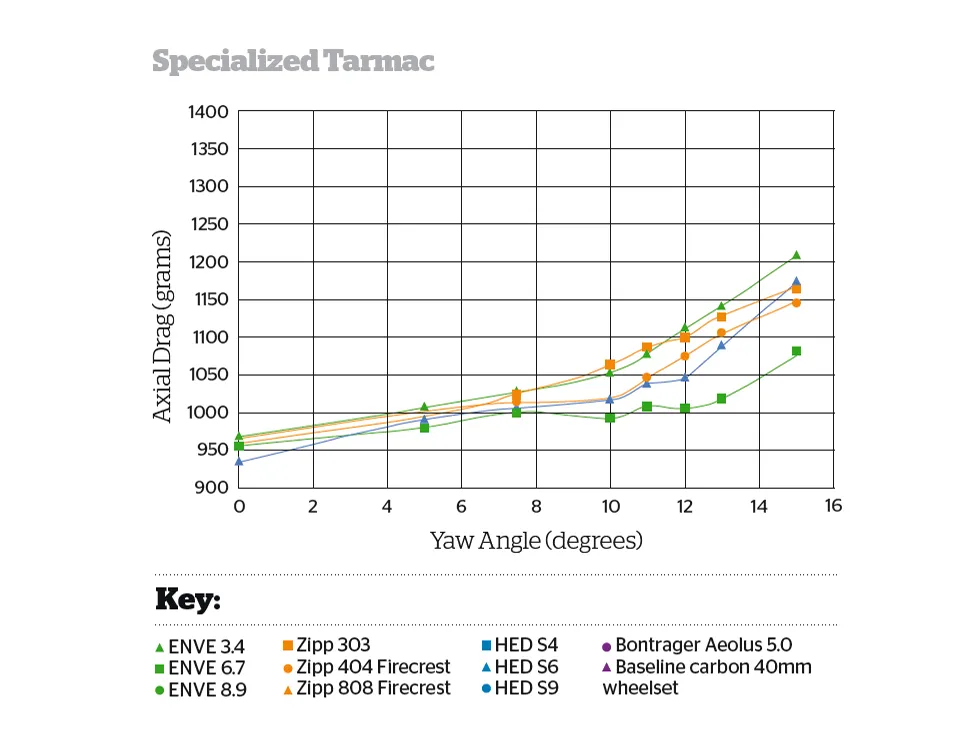
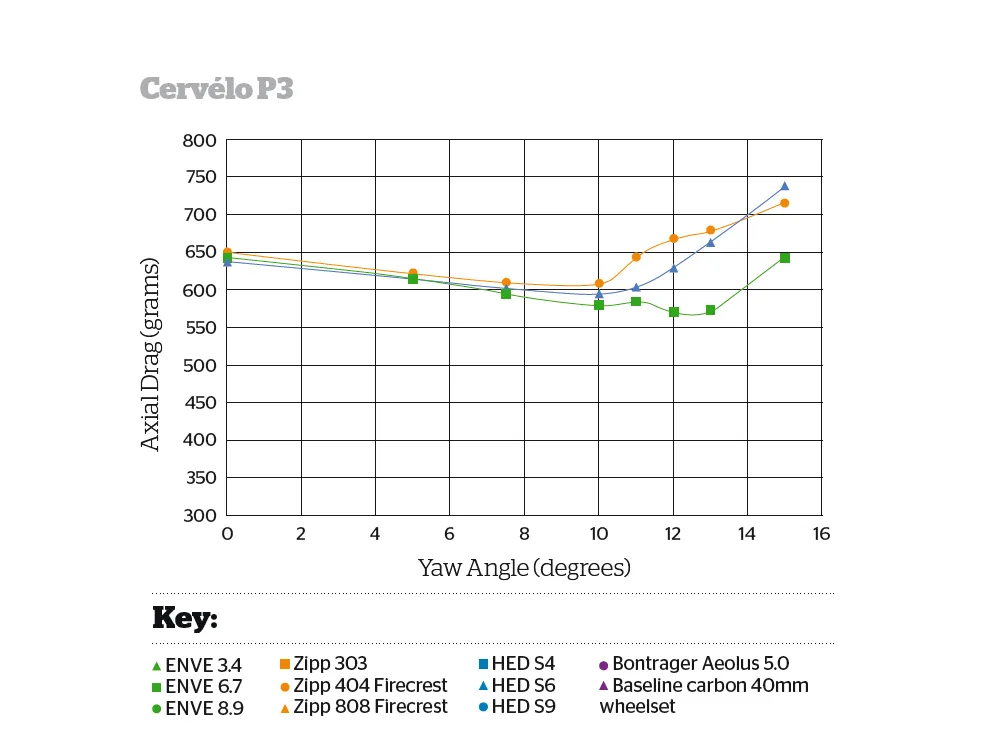
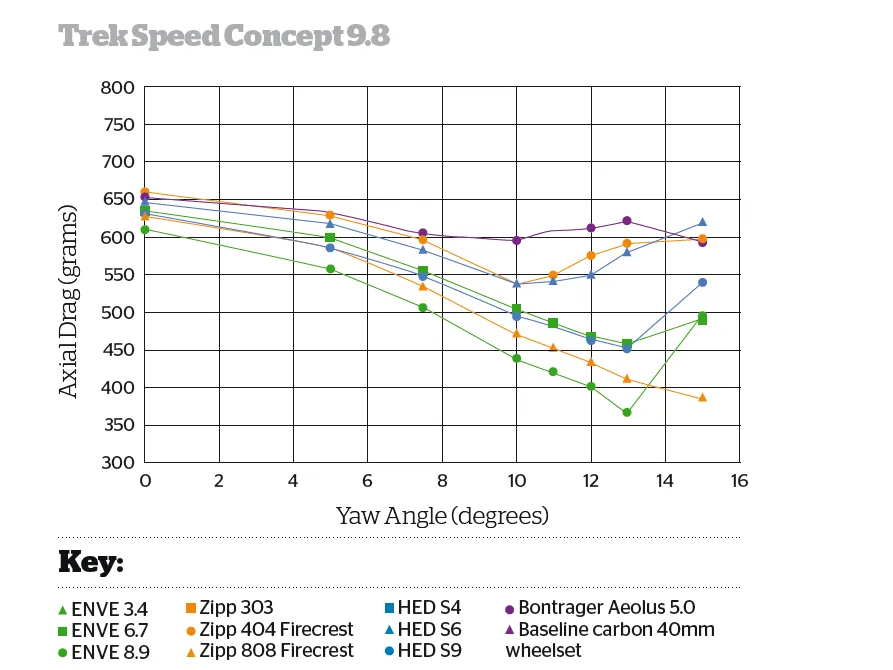
Grams of drag: a measure of the size of the aerodynamic force acting against the object. The lower the better. At 30mph (48km/h), a reduction of 50g of drag force is roughly equivalent to a time saving of 0.5sec/km, or 20sec in 40km.
Yaw angle: the angle between the direction of travel and the direction of the wind.
Stability

It’s one thing for a wheel to be aerodynamically effective in a varying crosswind but it’s quite another for it to be rideable. Ease of handling and confidence stem from predictable behaviour which in turn owes everything to a linear response from the wheel as the crosswind changes. As is so often the case in any interaction between man and machine, from the brakes in your car to your PC’s mouse, linearity allows the user to calibrate their actions and working in harmony with the machine – in this case, their bike.
Smart’s wind tunnel rig allowed him to measure the steering torque applied to the front wheel by a crosswind. Baseline tests with existing wheels that were known to be tricky to ride in gusty conditions showed a non-linear response to crosswinds. That is, as the wind angle increases you might have to steer into it more but then if it increases again past a certain point then you would need to steer against it a lot less.
By designing this in from an early point, Enve and Smart were able to achieve a near-perfect ratio of steering input to angle. That means that you can run your deeper, faster wheels when everyone else is reaching for their skinny back-ups.
Ready to launch
The Smart Enve System goes on sale in June 2011, led out by the 6.7, which will be priced at £2100/US$2900). The 3.4 will be available around September and the 8.9 by the end of 2011.
There’s no doubt that it has the performance to shake up the market but, even so, for a relative newcomer to challenge the hegemony of Zipp and Hed will be seen as brave.
The point certainly isn’t lost on Enve co-founder Jason Schiers: “We know that what we’re doing is like picking a fight with an 800lb gorilla. There are some good products out there but after more than 1,000 individual tests and hundreds of hours in the Mercedes GP wind tunnel we know that we’ll have the lightest, strongest and fastest wheels.
“What we’re launching now is just the tip of the iceberg. We know we can keep this momentum going and we’ve no intention of letting off the gas.”
Smart Enve System
3.4: 35mm front, 45mm rear, 1250g/pair. A climbing wheel with aero properties that can do anything from mountain stages to sportives. Excellent stability makes it ideal for time trials or triathlons on windy days.
6.7: 60mm front, 70mm rear, 1415g/pair. Extremely fast mid-depth wheelset with a stability index suitable for experienced riders in all conditions and novice riders on calmer days. Best weight and stiffness in its depth category.
8.9: Exact specification and weight to be confirmed. Class leading weight, stiffness and stability. Usable by experienced riders in all but the windiest conditions.
Weights are for wheels built with 20/24 Sapim CX Ray spokes and DT Swiss 240s hubs.
The complete version of this article was originally published in Procycling magazine issue 152, June 2011.
